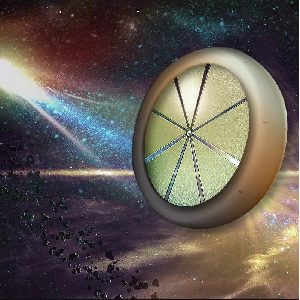Samara scientists are developing a space solar sailboat that can overtake the fastest probes and reach remote corners of space. Samara University press centre informed that it will also help to unravel the origin of comets, test the general theory of relativity in practice and provide electricity to future Martian colonists.
According to the words of a research participant, a member of the International Academy of Astronautics, Director of the Centre for Theoretical Physics of the City University of New York, Professor Roman Kezerashvili, a new sail, unlike previous versions, will be a round inflatable structure and will be able to receive jet acceleration without additional engines.
"Our device is a torus, in other words – a"bagel", in which the middle part is covered with a plate. The plate is a solar sail, it will open due to the fact that the inert xenon gas enters the torus at a certain moment and inflates the entire structure. The hull will be covered with a special substance that will begin to evaporate when the sailboat approaches the Sun and that will provide acceleration on the principle of a jet engine", – said Kezerashvili.
The scientist noted that the evaporation of matter from the sail surface will make it possible to move quickly using the pressure of sunlight. This will help to get to the mysterious Oort cloud at the edge of the solar system, where, according to scientists, comets are born.
“The duration of flights to other stars is gigantic. The fastest space probe “Voyager-1” will take 300 years to reach the Oort cloud. Our sail is able to reach it in 20-30 years. This means that we or the next generation will be able to obtain evidence of the existence of a cloud that supposedly generates all comets and study the remains of the formation of the solar system that were left about 4.6 billion years ago", – said Head of the research project, Professor at Samara University Space Engineering Department Olga Starinova.
Using the solar sail, it will be possible to solve other problems: to prove the fundamental laws of physics that cannot be obtained on the Earth (for example, the general theory of relativity), to “warm” Mars, where the average temperature is minus 50 ° C, reflecting the sun's rays even at night. This will provide the necessary temperature and increase the generation of electricity at the Martian base.
According to Starinova, at the Department of Space Engineering the options for sailboat flights to all the planets of the solar system have already been calculated. Small sailboats can stay in the orbits near Jupiter, Saturn or Mars for a long time, transmitting scientific data to the Earth. At present, the trajectories calculation of the travel to the sun is being done.
"We must calculate the trajectories that will allow us to get as close to the Sun as possible, as well as to pump the sail with solar energy, without burning it. This becomes especially significant when we talk about distant missions, for example, to Alpha Centauri", – said Starinova.
Samara University students are also involved in the development of a solar sail. The students of three master's degree programmes take part in it: “Dynamics and Motion Control of Space Systems”, “Advanced Space Technologies and Experiments in Space”, and “Technological Innovations in the Production of Rocket and Space Units”.
Source: ria.ru
 RU
RU  EN
EN  CN
CN  ES
ES 